In primary school, my classroom had a "reading corner" of pre-loved books. There, I found a remarkable treasure — a red novel with an intriguing front cover depicting a girl transforming into a cat.
The book carried the name Animorphs — a YA series spanning 60 books that has remained my favourite book series.
Animorphs begins when five kids walk through a construction site and witness a spacecraft crash. Jake, Rachel, Tobias, Cassie and Marco encounter a dying alien named Elfangor, who warns them that Earth is being invaded by another parasitic race called Yeerks.
In their natural form, Yeerks are almost blind and deaf slugs. But they can enslave host bodies and have been infiltrating human society, turning people into Controllers.
Elfangor decides to share his people's morphing technology to help fight the Yeerks and save humanity. The kids gain the ability to acquire DNA from any living creature and transform into animals. They name their tiny army "animorphs" — a portmanteau of "animal" and "morph".
One of the most thrilling aspects is how the Animorphs choose different animal species for various purposes. They acquire battle morphs like a Siberian tiger, silverback gorilla and grizzly bear for combat.
They gather insect morphs like flies, fleas and cockroaches for concealment, espionage and escape. Multiple bird species are used for specific situations — birds-of-prey for long-distance flights, owls for night travel, and seagulls for ocean-going missions.
The author, K.A. Applegate, wrote the series to promote love and respect for animals by showing how Earth's animal species are as wonderous and fantastic as any alien species imaginable.
Reading Animorphs as a child taught me amazing things about animals. I remember being surprised at learning that bird bones are hollow and the fur of polar bears is not truly white but translucent.
Animorphs is famed for its maturity and depth. For example, the morphing process parallels the discomfort teenagers experience during puberty as their bodies change in unexpected ways.
The kids are always uneasy at the strange transformations their bodies undergo when becoming other species.
The importance of liberty and free will are other themes Animorphs explores. To stop the Yeerks, the kids learn the importance of fighting to protect our freedom.
The series also unflinchingly confronts the horrors of warfare, including the psychological trauma of combat. As child soldiers, each animorph experiences intensely emotional and personal ethical dilemmas.
For example, Cassie is a staunch pacifist. Yet, in battle, she must routinely kill to defend herself, her friends and humankind. She struggles to reconcile the need to take life with her belief that all life, including those of her enemies, is sacred. As a child, I used to think Cassie's frequent moralising was a drag, especially when insisting that the Animorphs follow a strict moral code.
Rereading Animorphs as an adult, I've come to appreciate Cassie. She ensures the Animorphs never compromise their compassion or sacrifice their humanity in their fight to save humankind.
She was also ahead of her time — long before ethics surrounding human genetics became mainstream — that the animorphs ask for consent before acquiring human DNA for morphs.
My favourite animorph, Rachel, can best be described as a joyful warrior, always eager for a fight and her friends rely on her fearlessness in battle.
But as Rachel develops an obvious bloodlust, the others become weary of her recklessness and fear she will lose control.
While Rachel resents her friends for using her to avoid bloodying their hands further, she is also distressed at realising her addiction to war and worries she will not be able to return to normal once the war ends.
Perhaps the most profound animorph is Tobias. An early casualty of the war, Tobias became trapped permanently in morph as a red-tailed hawk.
Although he embraces his new body, Tobias yearns for the most basic elements of human life like eating at a table, sleeping indoors or shaking hands.
Always philosophical, Tobias constantly wonders about his strange hybridity: "Who am I? What am I? A bird. A boy. Something not quite human. Something more than human."
These questions parallel the quest to understand themselves and their place in the world that teenagers experience.
Animorphs, at its heart, is a very human story about our world: the cost of conflict, the price of freedom and the amazing things young people can accomplish when given opportunities.
The writer hopes to share insights into books and films to inspire appreciation for the power of stories
The views expressed in this article are the author's own and do not necessarily reflect those of the New Straits Times





